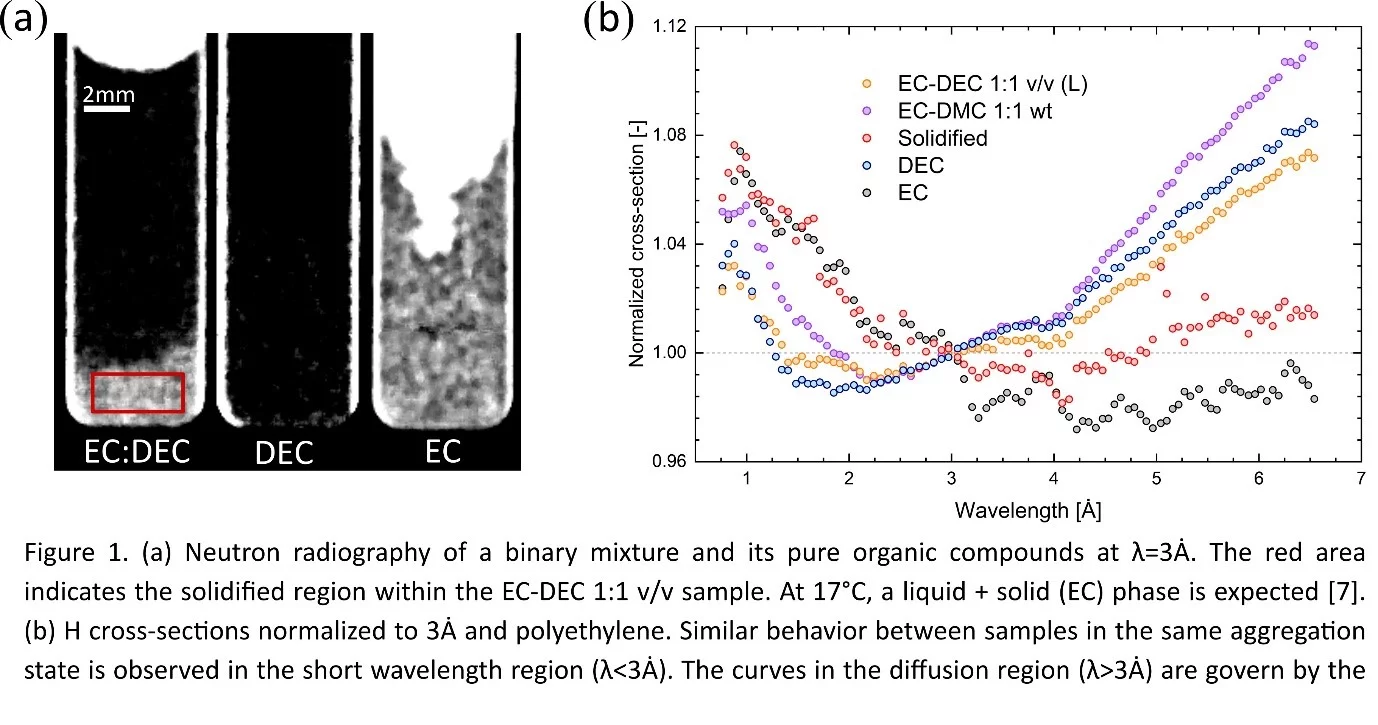The Lithium conducting electrolyte is a critical component of Li-ion batteries, as it has an important impact on performance and its durability, in particular in case of extreme environmental conditions. At low temperatures, a partial solidification can occur, while high temperatures can promote the degradation of the electrolyte. Using time-of-flight (ToF) neutron radiography, the possibility of imaging such changes in a fully non-invasive manner was demonstrated for the first time.
The hydrogen contained in Li-ion battery electrolytes has a very large neutron scattering cross section, resulting in a strong contrast of the electrolyte in neutron imaging. Moreover, due to inelastic scattering interactions, the intensity of transmitted neutrons does not only depend on the concentration of hydrogen atoms but also on their motions due to diffusion or molecular vibrations. These contributions can be evidenced using ToF neutron radiography, which allows to measure the transmission as a function of the neutron wavelength. The impact of both chemical composition and aggregate state on the neutron transmission spectrum were identified in measurements on solvent mixtures used for battery electrolytes. In particular, in an ethylene carbonate (EC) / di-ethyl carbonate (DEC) mixture at 17°C exhibiting sedimentation, an important different in neutron transmission spectra was observed between the solidified and liquid regions, with a much flatter wavelength dependency at long wavelengths. The reason for this change is both a composition change – as the sediment region is expected to be enriched with the EC component – and a suppression of the diffusion in the solidified component. This result illustrates the ability of ToF neutron radiography to image changes occurring to battery electrolytes as a result of extreme conditions or of degradation. In contrast with other methods for electrolyte analysis such as Fourier Transform Infrared Spectroscopy (FTIR), the interest of neutron imaging is its fully non-invasive aspect, as neutrons can be transmitted through non-transparent materials and even metallic casings. In summary, the obtained results pave the way for in situ analysis of electrolyte characteristics in Li-ion batteries.
Contact
Dr. Pierre Boillat
Head of Neutron Imaging of Electrochemical Systems Group
Paul Scherrer Institut
5232 Villigen PSI
Switzerland
Telephone: +41 56 310 27 43
E-mail: pierre.boillat@psi.ch
Eric Ricardo Carreón Ruiz, PhD
Neutron Imaging of Electrochemical Systems Group
Paul Scherrer Institut
5232 Villigen PSI
Switzerland
Telephone: +41 56 310 57 72
E-mail: ricardo.carreon@psi.ch
Original Publication
Study of Phase Changes in Lithium-Ion Battery Electrolytes via Spectroscopic Neutron Imaging
R. Carreon-Ruiz, G. Burca, M. Cochet, P. Kadletz, J. Lee, A.S. Tremsin, E. Winter, R. Woracek, M. Zlobinski, L. Gubler, P. Boillat
240th meeting of the Electrochemical Society, October 10-14, 2021 (Digital meeting).

